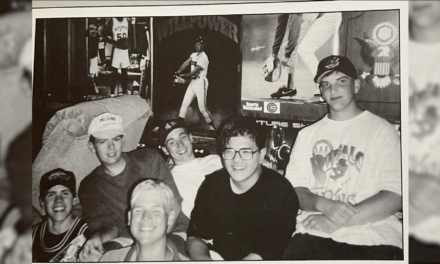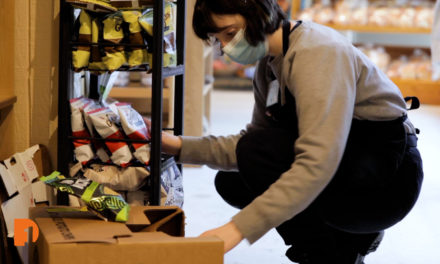Two years after the COVID-19 pandemic touched down in Michigan in March 2020, where does the state stand in the fight against COVID-19? As the pandemic has eased its hold on the state’s public health and economy, so too have the state’s restrictions around mask mandates, social distancing, and other guidelines. Still, some Michiganders have questions about where we go from here.
RELATED: COVID-19’s Impact on Communities
RELATED: Making a Choice: How Detroiters Feel About Face Masks for COVID-19
RELATED: What Happens If You Get Exposed to COVID-19 or Need to Get Tested for Work?
One Detroit’s Bill Kubota sits down with Michigan’s top medical executive, Dr. Natasha Bagdasarian, to learn about the recommendations and strategies still in place in the state to fight against COVID-19. Plus, Dr. Bagdasarian clears up questions about vaccinations, booster shots and the recently lifted mask mandate.
Full Transcript:
Bill Kubota: Let’s talk infection rates, vaccinations, and hospitalizations. What are the numbers? Where are things now? Where are they going?
Dr. Natasha Bagdasarian, Chief Medical Executive, State of Michigan: Well, I can tell you that in general, we are in a low. We’re in a low point here with cases and hospitalizations. And what that means is, when we think about the pandemic, we’re really thinking about this in a cycle. We’re thinking about different approaches depending on where things are overall in the state. Right now, we are in a recovery phase. And what that means is that we just got over this big surge in the winter. We just got over our Delta and Omicron surges back-to-back. We now are in a place where transmission is low, and we do have some protection based both upon vaccination as well as some prior immunity from that very recent Omicron surge.
So, we’re in a relatively good spot at the moment. However, when we think about where we’re heading in the pandemic, we do expect to see future surges of cases. We do expect cases and hospitalizations even to go up at times in the future. And when we think ahead, what does that look like? That could be the emergence of a new variant. It could be schools reopening in the fall; we have seen surges of cases around school reopening in the past. It could be around colder weather in the winter.
So, we’re looking at this as really being a phased approach to the pandemic. We’re in recovery right now, but that doesn’t necessarily mean it is all smooth sailing. Because as you know, we have the BA.2 subvariant that we are closely monitoring and it’s causing increased cases in other parts of the world and in other parts of the country. And we do expect to see a rise in our cases here in Michigan.
Bill Kubota: But on top of that, we’re also looking at that push for that second booster. How does that fit into all of this?
Dr. Natasha Bagdasarian: Well, again, vaccines are one of the most important tools that we have. We really have to use all of these tools in a very holistic approach and use them together. So, you are safest, if you are using our, what we call non-pharmaceutical interventions, meaning you avoiding very large, very crowded gatherings. You’re doing what you can to prevent getting exposed to the disease as much as you can. And then, also you are making sure you’re vaccinated and boosted, so up to date with vaccinations.
That you’ve spoken to your doctor, that you have a plan for whether or not you’d be eligible for one of these COVID therapeutics and then making sure that you’ve got some of these tools at home. So, making sure that you’ve got masks and hand sanitizer on hand for future surges, making sure that you’ve got over-the-counter tests on hand so that you can use those over-the-counter tests if you become symptomatic if you’ve been exposed to someone with COVID or before attending a large gathering. So, making sure that people have all of these tools at their disposal is really one of the keys to moving forward.
Bill Kubota: You know, a federal judge just recently, very recently kind of lifted this mask mandate on airplanes and transportation. What about that? What do you think? Will you still be wearing your mask on a plane now?
Dr. Natasha Bagdasarian: You know, we have been saying for some time now that we’re in a phase of the pandemic where making these sorts of decisions are really up to individuals. So, we now have access to well-fitting high-quality masks that can protect the wearer. In the beginning, when we were talking about cloth masks and masks that were not well-fitting, really, everyone had to wear a mask in order to prevent spread from happening. But now, if you are wearing a really high-quality well-fitting, multilayered mask, you can provide protection to yourself. And so, people need to make decisions that work for them.
So, we still recommend wearing a mask if you are unwell, if you’ve tested positive, or if you are quarantining, for example. So, there are still sometimes we would recommend masking. If you’re in a high-risk congregate setting, so if you’re in a health care setting or a long-term care facility, that’s another time to mask up. And then, we also want people to comply with local and federal rules. So, if there are any laws, mandates, rules around masking in the place you’re going to, it’s important to comply with those rules. But overall, people can now make decisions that work for them. And there are lots of different reasons why people may want to continue wearing a mask.
So, number one, you may have young children who aren’t eligible for the vaccine yet, you may be immunocompromised yourself, someone in your family may be immunocompromised, you may be wearing a mask for them. And then, there’s also just wearing a mask to be considerate to others. You don’t know who’s around you. You don’t know if there are people who are very vulnerable, who are sitting next to you. And so, you may wear a mask for them and for their comfort. And so, when you ask if I will continue wearing a mask, I do generally wear masks when I’m in public, when I’m in especially indoor public settings. But again, it’s a personal decision that I make with my family and do what’s best for us, and people have to make those decisions for themselves as well.
Bill Kubota: Yeah. You mentioned your family and children, how are schools doing and dealing with all of this these days?
Dr. Natasha Bagdasarian: I think it has been a very hard 2 years for schools. I think schools have been put at the front line of this pandemic. And really, they want to get back to the business of educating our kids, which is their primary goal. But they also need to be able to stay open and make sure that kids are healthy enough to be able to stay in school. And that does mean preventing outbreaks. And when I talk about those tools and I mentioned that vaccines are one of the most important tools that we have, we see that vaccines have not been utilized to the degree we would want them to be in our younger age groups.
So, when we look at overall vaccination, we’re at above 60% for vaccine uptake across the state. But when we look at our younger age groups, when we look at our pediatric population, the 5 to 11 population, that’s lower, that’s at about 28% statewide. And then, when we look at certain communities, that rate, especially in children, drops even lower. And when we look at communities of color, again, we’re seeing lower vaccine uptake. And that matters because we are expecting future surges of cases. And we need to make sure that everyone and all communities across the state are protected. So, if we don’t have vaccine uptake in that younger age groups, we could be seeing school closures again in the fall, school closures into next year and even beyond.
We could be seeing outbreaks in schools. And then, of course, we know that children who are exposed and transmitting in school settings, for example, can bring those infections back to their family members and to vulnerable, grandparents or younger siblings. So, we really need to make sure that vaccine rates are up across the board because if we are not all protected, if we have vulnerable individuals, vulnerable communities among us, then as a state, we’re not going to be able to move out of this pandemic.
Stay Connected:
Subscribe to One Detroit’s YouTube Channel & Don’t miss One Detroit Mondays and Thursdays at 7:30 p.m. on Detroit Public TV, WTVS-Channel 56.
Catch the daily conversations on our website, Facebook, Twitter @DPTVOneDetroit, and Instagram @One.Detroit
View Past Episodes >
Watch One Detroit every Monday and Thursday at 7:30 p.m. ET on Detroit Public TV on Detroit Public TV, WTVS-Channel 56.




